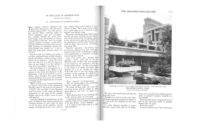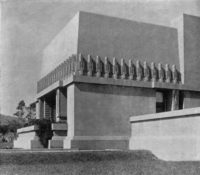From Architectural Record, January, 1928. Read a PDF of the original article here.
PLAN! There is something elemental in the word itself. A pregnant plan has logic – is the logic of the building squarely stated. Unless it is the plan for a foolish Fair.
A good plan is the beginning and the end, because every good plan is organic. That means that its development in all directions is inherent – inevitable.
Scientifically, artistically to foresee all is “to plan.” There is more beautify in a fine ground plan than in almost any of its ultimate consequences.
In itself it will have the rhythms, masses and proportions of a good decoration if it is the organic plan for an organic building with individual style – consistent with materials.
All is there seen – purpose, materials, method, character, style. The plan? The prophetic should of the building – a building that can live only because of the prophecy that is the plan. But it is a map, a chart, a mere diagram, a mathematical projection before the fact and, as we all have occasion to know, accessory to infinite crimes.
To judge the architect one need only look at his ground plan. He is master then and there, or never. Were all elevation of the genuine buildings of the world lost and the ground plan saved, each building would construct itself again. Because before the plan is a plan it is a concept in some creative mind. It is, after all, only a purposeful record of that dream which saw the designed building living in its appointed place. A dream – but a precise and practical, the record to be read by the like-minded.
The original plan may be thrown away as the work proceeds – probably most of those for the most wonderful buildings in the world were, because the concept grows and matures during realization, if the master-mind is continually with the work. But that plan had, first, to be made. Ultimately it should be corrected and recorded.
But to throw the plans away is a luxury ill afforded by the organizations of our modern method. It has ruined owners and architects and enriched numberless contractors. Therefore conceive the building in the imagination, not on paper but in the mind, thoroughly – before touching paper. Let it live there – gradually taking more definite form before committing it to the draughting board. When the thing lives for you – start to plan it with tools. Not before. To draw during conception or “sketch,” as we say, experimenting with practical adjustments to scale, is well enough if the concept is clear enough to be firmly held. It is best to cultivate the imagination to construct and complete the building before working upon it with T square and triangle. Working on it with triangle and T square should modify or extend or intensify or test the conception – complete the harmonious adjustment of its parts. But if the original concept is lost as the drawing proceeds, throw all away and begin afresh. To throw away a concept entirely to make way for a fresh one – that is a faculty of the mind not easily cultivated. Few have that capacity. It is perhaps a gift – but may be attained by practice. What I am trying to express is that the plan must start as a truly creative matter and mature as such. All is won or lost before anything more tangible begins.
The several factors most important in making the plans – after general purpose or scheme or “project” are,
2nd – Materials.
3rd – Building methods.
4th – Scale.
5th – Articulation.
6th – Expression or Style.
In the matter of scale, the human being is the logical norm because buildings are to be humanly inhabited and should be related to human proportions not only comfortably but agreeably. Human beings should look as well in the building or of it as flowers do.
People should belong to the building just as it should belong to them. This scale or unit-of-size of the various parts varies with the specific purpose of the building and the materials used to build it. The only sure way to hold all to scale is to adopt a unit-system, unit-lines crossing the paper both ways, spaced as pre-determined, say 4’-0” on centers – or 2’8” or whatever seems to yield the proper scale for the proposed purpose. Divisions in spacing are thus brought into a certain texture in the result; ordered scale in detail is sure to follow.
A certain standardization is established here at the beginning, like the warp in the oriental rug. It has other and economic values in construction. I have found this valuable in practice even in small houses. Experience is needed to fix upon the proper size of the unit for any particular building. Trained imagination is necessary to differentiate or syncopate or emphasize, to weave or play upon it consistently.
Scale is really proportion. Who can teach proportion? Without a sense of proportion, no one should attempt to build. This gift of sense must be the diploma Nature gave to the architect.
Let the architect cling, always, to the normal human figure for his scale and he cannot go so far wrong as Michelangelo did in St. Peter’s at Rome. St. Peter’s in invariably disappointing as a great building, for not until the eye deliberately catches a human figure for purposes of comparison does one realize that the building is vast. All the details are likewise huge and the sense of grandeur it might have I the great masses were qualified by details kept to human scale – this effect of grandeur – is lost in the degradation of the human figure. A strange error for a sculptor to make.
The safest practice in proportion is not to attempt to allow for “perspective”, stilting domes as he did, changing pitches of roofs as many do, and modifying natural lines and masses to meet certain views from certain vantage points as the Greeks are said to have done, but to make the constitution of the right in itself. Let the incidental perspectives fall when and how they will. Trust nature to give proper values to a proper whole. The modifications she may make are better than any other. There is something radically wrong with a scheme that requires distortion to appear correct.
In the matter of materials. These also affect scale. The logical material under the circumstances is the most natural material for the purpose. It is usually the most beautiful – and it is obvious that sticks will not space the same as stones nor allow the same proportions as steel. Nor will the spacing adjustable to these be natural to made-blocks or to slabs or to a plastic modeling of form.
Sticks of wood will have their own natural volume and spacing determined by standards of use and manufacture and the nature of both.
A wood plan is slender: light in texture, narrower spacing.
A stone or brick plan is heavy: black in masses, wider in spacing.
Combination materials: lightness combined with massiveness.







Post a comment to this article
Report Abusive Comment